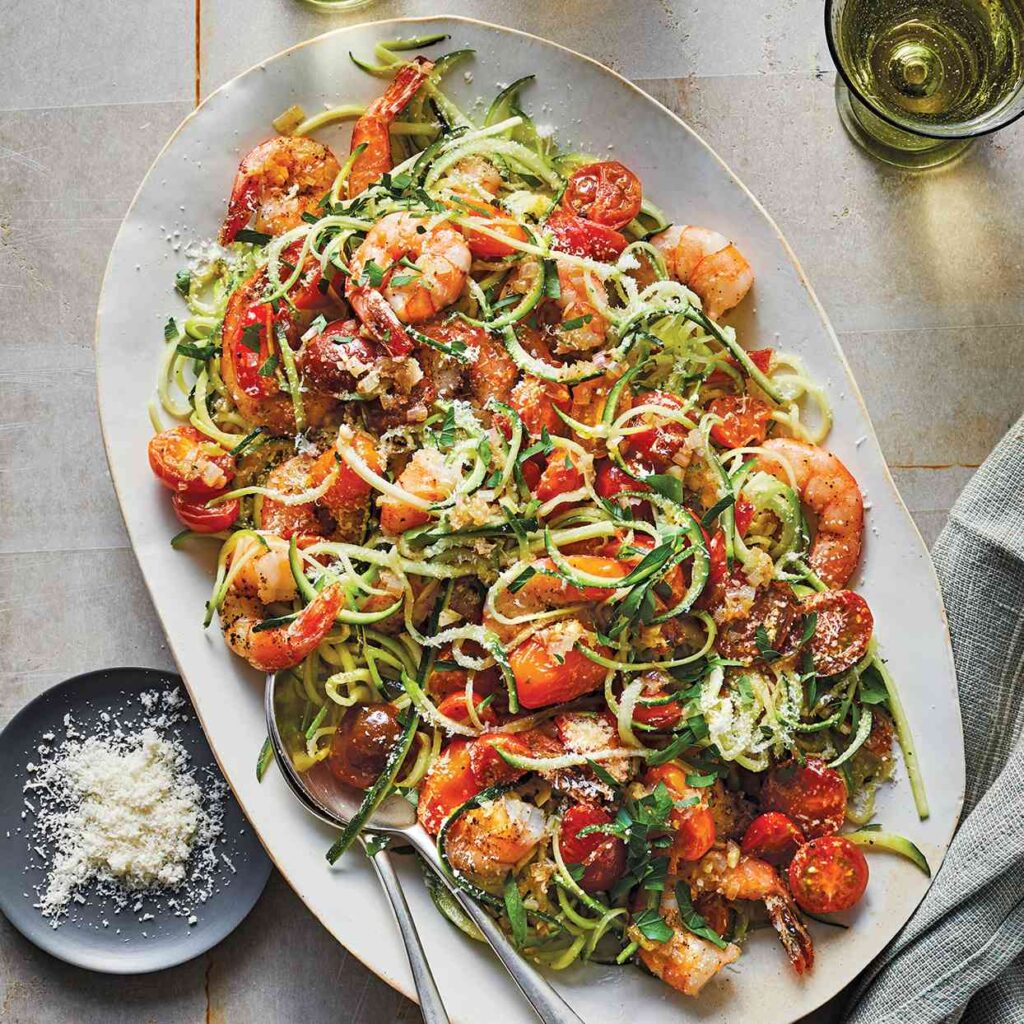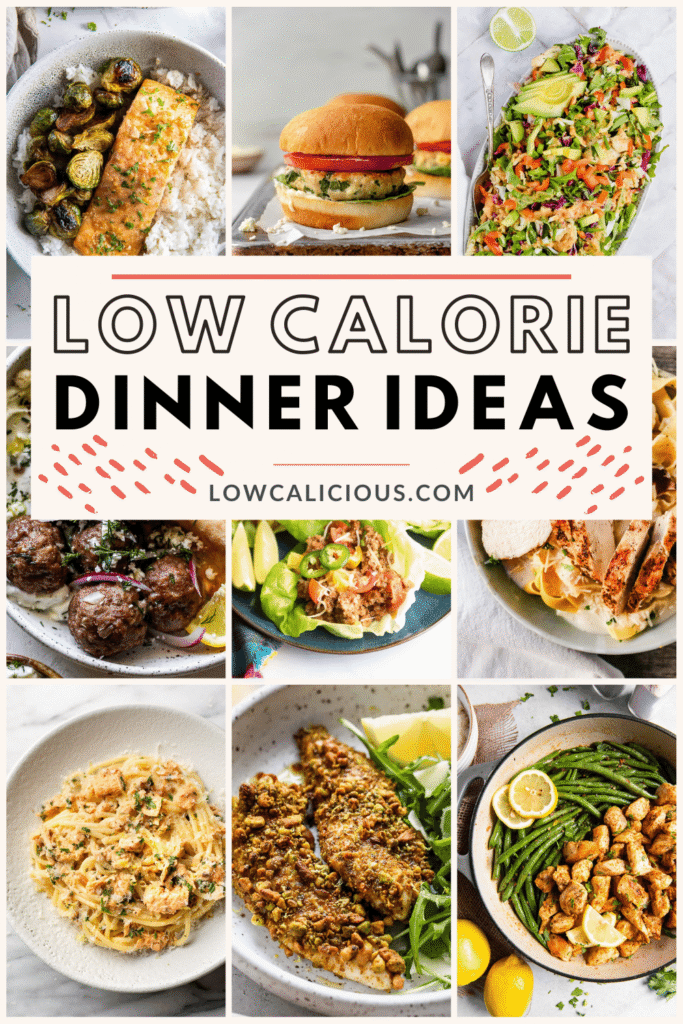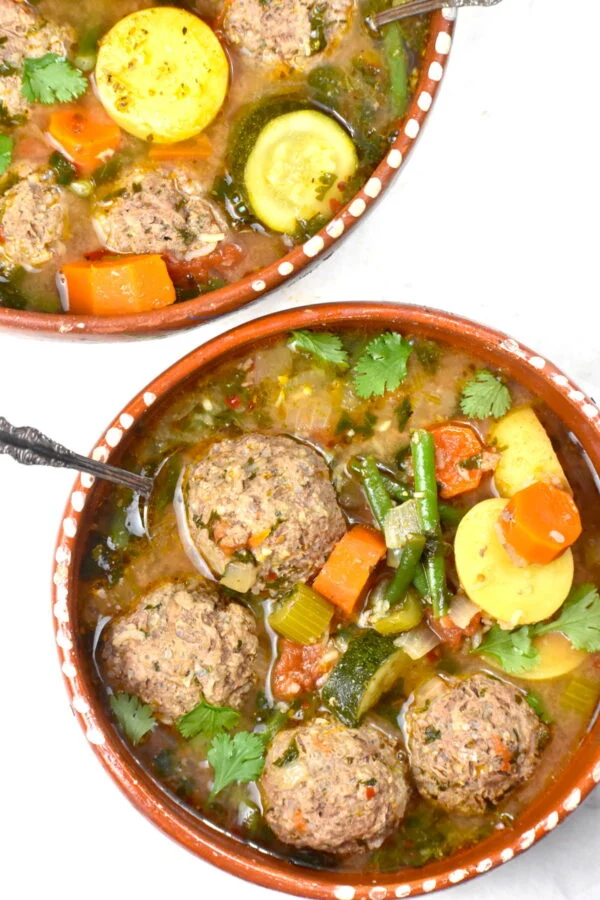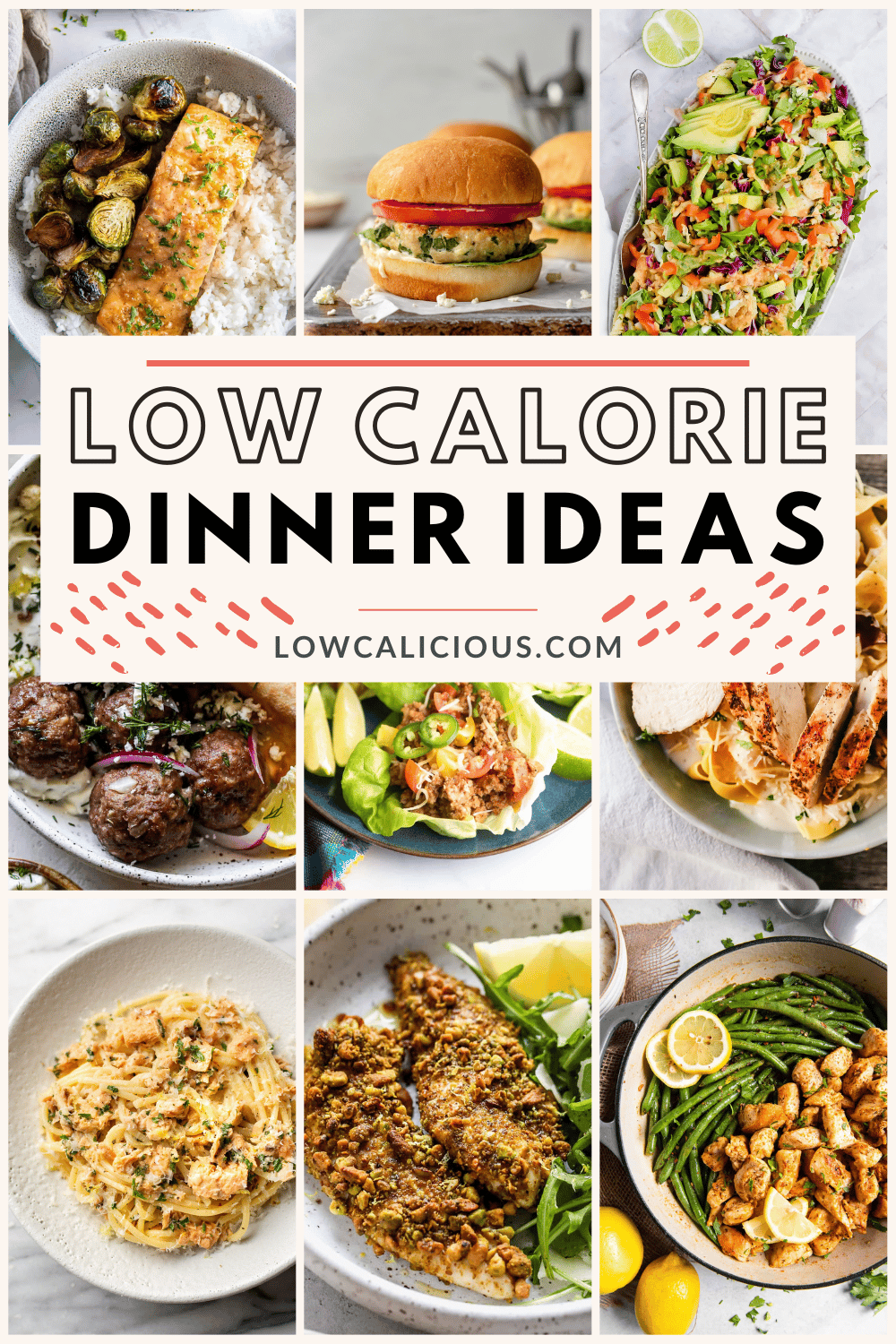Maintaining a balanced diet is key to a healthy lifestyle, and dinner is often the meal where we want to keep things nutritious yet satisfying. Low-calorie dinners can help you stay on track with your health goals without sacrificing flavor or variety. At https://tastetrove.net/ we believe in making healthy eating accessible and delicious. This article explores a variety of low-calorie dinner ideas that are packed with nutrients, easy to prepare, and perfect for a balanced diet. Whether you’re aiming for weight loss, better energy levels, or simply a healthier lifestyle, these recipes will inspire your evening meals.
Why Choose Low-Calorie Dinners?
Low-calorie dinners are a great way to manage your daily caloric intake while ensuring you get essential nutrients. According to the CDC, a balanced diet includes a variety of foods like vegetables, lean proteins, whole grains, and healthy fats. By focusing on low-calorie options, you can enjoy generous portions without overloading on calories, leaving room for nutrient-dense ingredients that fuel your body. These dinners are also ideal for those following weight management plans or seeking to improve overall wellness.
At Astetrove, we’ve shared tips on healthy meal planning to help you organize your week with nutritious meals. Incorporating low-calorie dinners into your routine can reduce the risk of overeating at night, improve digestion, and promote better sleep. Below, we’ve compiled a selection of low-calorie dinner recipes, each under 400 calories per serving, that are flavorful, satisfying, and easy to make.
A Low-Calorie Dinner is key to maintaining a balanced diet while supporting weight management goals. Preparing a Low-Calorie Dinner with nutrient-dense ingredients like leafy greens, lean proteins, and whole grains ensures satisfaction without excess energy intake. For example, a Low-Calorie Dinner such as grilled salmon with steamed broccoli keeps calories under 400 while delivering omega-3s and fiber. Variety in a Low-Calorie Dinner, like swapping pasta for zucchini noodles, prevents dietary boredom and boosts veggie intake. Ultimately, a well-planned Low-Calorie Dinner promotes health, satiety, and sustainable eating habits.
1. Grilled Lemon Herb Chicken with Veggie Skewers
Calories: Approximately 300 per serving
Prep Time: 25 minutes
Serves: 2
This vibrant dish combines lean protein with colorful vegetables for a nutrient-packed meal. The lemon herb marinade adds zest without extra calories.
Ingredients:
- 2 boneless, skinless chicken breasts (4 oz each)
- 1 zucchini, sliced
- 1 red bell pepper, chopped into chunks
- 1 red onion, quartered
- 1 tbsp olive oil
- Juice of 1 lemon
- 1 tsp dried oregano
- 1 tsp garlic powder
- Salt and pepper to taste
- Wooden or metal skewers
Instructions:
- In a bowl, mix olive oil, lemon juice, oregano, garlic powder, salt, and pepper to create a marinade.
- Cube the chicken and marinate for 15 minutes.
- Thread chicken, zucchini, bell pepper, and onion onto skewers.
- Grill on medium heat for 10-12 minutes, turning occasionally, until chicken is cooked through.
- Serve with a side of mixed greens for added fiber.
This recipe is high in protein and fiber, making it filling and supportive of muscle maintenance. For more protein-rich ideas, check out our article on high-protein low-calorie meals.

2. Zucchini Noodles with Tomato Basil Sauce
Calories: Approximately 200 per serving
Prep Time: 20 minutes
Serves: 2
Zucchini noodles, or “zoodles,” are a fantastic low-calorie alternative to pasta. Paired with a homemade tomato basil sauce, this dish is light yet satisfying.
Ingredients:
- 2 large zucchinis, spiralized
- 1 cup cherry tomatoes, halved
- 1 tbsp olive oil
- 2 garlic cloves, minced
- 1/4 cup fresh basil, chopped
- 1/2 tsp red pepper flakes (optional)
- Salt and pepper to taste
- 1 tbsp grated Parmesan (optional)
Instructions:
- Heat olive oil in a skillet over medium heat. Add garlic and sauté for 1 minute.
- Add cherry tomatoes and cook until softened, about 5 minutes.
- Stir in basil, red pepper flakes, salt, and pepper. Simmer for 2-3 minutes.
- Add zucchini noodles to the skillet and toss for 2-3 minutes until tender.
- Top with Parmesan, if desired, and serve immediately.
This dish is rich in vitamins A and C, thanks to the zucchini and tomatoes. For more vegetarian inspiration, visit Minimalist Baker for plant-based recipes.
3. Baked Salmon with Asparagus and Quinoa
Calories: Approximately 350 per serving
Prep Time: 30 minutes
Serves: 2
Salmon is a heart-healthy protein rich in omega-3 fatty acids, and pairing it with asparagus and quinoa creates a balanced, low-calorie meal.
Ingredients:
- 2 salmon fillets (4 oz each)
- 1 bunch asparagus, trimmed
- 1/2 cup quinoa, rinsed
- 1 tbsp olive oil
- 1 tsp Dijon mustard
- 1 tsp honey
- Juice of 1/2 lemon
- Salt and pepper to taste
Instructions:
- Preheat oven to 400°F (200°C).
- Cook quinoa in 1 cup water according to package instructions (about 15 minutes).
- Mix olive oil, mustard, honey, lemon juice, salt, and pepper to make a glaze.
- Place salmon and asparagus on a baking sheet. Brush salmon with glaze and drizzle asparagus with olive oil, salt, and pepper.
- Bake for 12-15 minutes until salmon flakes easily.
- Serve salmon and asparagus over a bed of quinoa.
This meal is high in protein and fiber, supporting heart health and satiety. Learn more about the benefits of omega-3s at Harvard Health.
4. Turkey and Veggie Lettuce Wraps
Calories: Approximately 250 per serving
Prep Time: 20 minutes
Serves: 2
These lettuce wraps are a low-carb, low-calorie alternative to traditional wraps, packed with lean turkey and fresh vegetables.
Ingredients:
- 8 oz lean ground turkey
- 1 head romaine lettuce, leaves separated
- 1/2 cup shredded carrots
- 1/2 cup diced cucumber
- 1/4 cup diced red bell pepper
- 1 tbsp low-sodium soy sauce
- 1 tsp sesame oil
- 1 tsp grated ginger
- 1 garlic clove, minced
Instructions:
- Heat sesame oil in a skillet over medium heat. Add garlic and ginger, sautéing for 1 minute.
- Add ground turkey and cook until browned, about 5-7 minutes. Stir in soy sauce.
- Spoon turkey mixture into lettuce leaves.
- Top with carrots, cucumber, and bell pepper.
- Roll up the lettuce leaves and serve.
These wraps are quick to prepare and perfect for a light dinner. For more low-carb ideas, explore our guide on low-carb meal prep.
5. Stuffed Bell Peppers with Cauliflower Rice
Calories: Approximately 280 per serving
Prep Time: 35 minutes
Serves: 2
Stuffed bell peppers are a colorful, nutrient-dense option that uses cauliflower rice to keep calories low.
Ingredients:
- 2 large bell peppers, halved and seeded
- 1 cup cauliflower rice
- 8 oz lean ground beef or turkey
- 1/2 cup diced tomatoes
- 1/4 cup diced onion
- 1 tsp cumin
- 1 tsp chili powder
- 1 tbsp olive oil
- Salt and pepper to taste
Instructions:
- Preheat oven to 375°F (190°C).
- Heat olive oil in a skillet and sauté onion until soft, about 3 minutes.
- Add ground meat, cumin, chili powder, salt, and pepper. Cook until browned, about 5-7 minutes.
- Stir in cauliflower rice and tomatoes, cooking for 2-3 minutes.
- Stuff bell pepper halves with the mixture and place in a baking dish.
- Bake for 20-25 minutes until peppers are tender.
This dish is high in fiber and protein, making it a filling option for a balanced diet. For more creative vegetable-based recipes, visit EatingWell.
Tips for Creating Your Own Low-Calorie Dinners
- Prioritize Vegetables: Fill half your plate with non-starchy vegetables like broccoli, spinach, or zucchini to add volume and nutrients without many calories.
- Choose Lean Proteins: Opt for chicken, turkey, fish, or plant-based proteins like tofu to keep calories in check while supporting muscle health.
- Use Healthy Fats Sparingly: Incorporate small amounts of olive oil, avocado, or nuts for flavor and satiety without overloading on calories.
- Experiment with Spices: Herbs and spices like cumin, paprika, or fresh basil can enhance flavor without adding sodium or calories.
- Portion Control: Use smaller plates or measure portions to avoid overeating, even with healthy ingredients.
For more tips on building a balanced diet, check out our article on creating nutrient-dense meals.
Why These Recipes Work for a Balanced Diet
Each of these recipes is designed to align with the principles of a balanced diet, which, according to the USDA, includes a mix of vegetables, fruits, grains, protein, and dairy or alternatives. By keeping calories low, these dinners allow you to enjoy flavorful meals while staying within your daily caloric goals. They’re also versatile, accommodating various dietary preferences like vegetarian, low-carb, or gluten-free.
At Astetrove, we’re committed to helping you live a healthier life through practical, delicious recipes. For more meal ideas, explore our collection of healthy recipes for busy lifestyles. You can also find additional resources on balanced eating at Healthline.
Conclusion
Incorporating low-calorie dinners into your routine doesn’t mean sacrificing taste or satisfaction. From grilled chicken skewers to zucchini noodles and stuffed peppers, these recipes prove that healthy eating can be both delicious and achievable. By focusing on nutrient-dense ingredients and mindful portions, you can support your health goals while enjoying every bite. Visit Astetrove for more healthy eating tips and recipes to keep your meals exciting and balanced.
FAQs on Healthy Low-Calorie Dinner Ideas for a Balanced Diet
Here are some common frequently asked questions based on expert nutrition advice and popular resources. These address key concerns about incorporating low-calorie dinners into a balanced diet, which emphasizes nutrient-dense foods like vegetables, lean proteins, whole grains, and healthy fats while keeping calories in check (typically under 500 per meal for weight management).
- What makes a dinner “healthy” and low-calorie while staying balanced?
A balanced low-calorie dinner should include a variety of food groups: plenty of colorful vegetables for fiber and vitamins, lean proteins (like chicken, fish, or beans) for satiety, whole grains or alternatives like cauliflower rice for sustained energy, and small amounts of healthy fats (e.g., avocado or olive oil). Aim for meals under 400-500 calories that provide at least 20g of protein and 5g of fiber to keep you full without excess energy. Avoid cutting out entire food groups; instead, focus on nutrient-dense options to support overall health and prevent nutrient deficiencies. - How many calories should a low-calorie dinner have?
For most adults aiming for weight loss or maintenance, a dinner around 300-500 calories is ideal, depending on your total daily needs (e.g., 1,500-2,000 calories overall). This allows room for breakfast, lunch, and snacks while creating a calorie deficit. Pair it with portion control and high-volume, low-calorie foods like salads or veggie stir-fries to feel satisfied. Always consult a doctor or dietitian for personalized goals, as needs vary by age, activity level, and metabolism. - How can I make low-calorie dinners filling without adding extra calories?
Incorporate volume-boosting ingredients like leafy greens, broccoli, or zucchini, which are low in calories but high in water and fiber. Add lean proteins such as grilled chicken, turkey, or legumes to promote fullness. Use herbs, spices, lemon, or vinegar for flavor instead of calorie-heavy sauces. Healthy fats in moderation (e.g., a drizzle of olive oil) also help sustain energy. Recipes like stuffed peppers or lettuce wraps can mimic comfort foods while keeping calories low. - Are low-calorie dinners suitable for weight loss, and what are the benefits?
Yes, when part of a balanced diet, low-calorie dinners can support gradual weight loss (1-2 pounds per week) by reducing overall intake without hunger. Benefits include better heart health, stable blood sugar, improved digestion from fiber-rich veggies, and reduced risk of chronic diseases like diabetes. Focus on whole foods over processed “diet” items, which may contain hidden sugars. Track progress with a food diary or app, and combine with exercise for sustainable results. - What are common mistakes to avoid in low-calorie meal planning?
Don’t rely on processed low-fat foods, as they often lack nutrients and can lead to overeating due to added sugars. Skipping protein or fiber can cause hunger later, so always include both. Over-restricting (e.g., under 1,200 calories daily) may slow metabolism or cause fatigue—aim for balance. Also, vary your meals to prevent boredom; rotate proteins and veggies weekly. Hydrate well, as thirst can mimic hunger. - Can low-calorie dinners be vegetarian or vegan?
Absolutely—options like lentil curries, chickpea stir-fries, or stuffed portobello mushrooms provide protein and fiber without meat. Use plant-based swaps like tofu or beans for satiety. Ensure balance with B12 sources (e.g., fortified foods) and healthy fats from nuts or seeds. Recipes under 400 calories, such as spinach and sweet potato curry, count toward your five-a-day veggie intake.

Healthy Low-Calorie Dinner Ideas for a Balanced Diet
These ideas are drawn from reliable sources and focus on quick, nutritious meals (most under 30 minutes) that emphasize balance: veggies for vitamins, proteins for muscle repair, and minimal processed carbs. Each serves 1-2 and is around 300-500 calories. Adjust portions as needed.
| Dinner Idea | Key Ingredients | Approx. Calories | Why It’s Balanced & Healthy |
|---|---|---|---|
| Grilled Chicken Caesar Wrap | Rotisserie chicken, romaine lettuce, low-cal Caesar dressing, whole-grain tortilla | 350 | High in lean protein (24g) and fiber from greens; quick veggie boost with low-fat dressing for flavor without excess calories. Ready in 20 minutes. |
| Seared Salmon with Charred Green Beans | Salmon fillet, green beans, garlic, capers, red chile | 400 | Omega-3-rich fish for heart health, plus fiber-packed veggies; under 30 minutes, with healthy fats for satiety. |
| Turkey Lettuce Wraps | Ground turkey, lettuce leaves, diced veggies (carrots, onions), low-sodium soy sauce | 300 | Lean protein (20g+), low-carb alternative to buns; Asian-inspired for variety, high in veggies for antioxidants. |
| Chickpea & Spinach Tomato Stew | Chickpeas, spinach, tomatoes, eggs, heavy cream (minimal) | 350 | Plant-based protein and iron from chickpeas/spinach; vegetarian, fiber-rich (7g+), and creamy without high calories. Serve with crusty bread if desired. |
| Lemon-Herb Baked Flounder with Couscous & Broccoli | Flounder fillet, couscous, steamed broccoli, lemon-thyme sauce | 400 | Low-fat fish for protein, whole grains for energy, and broccoli for vitamin C; zesty flavors keep it under 200 calories for the fish alone. |
| Cauliflower Rice Stir-Fry with Pork & Beans | Lean pork, mixed beans, cauliflower rice, veggies (peppers, onions) | 450 | Low-carb rice sub saves 100+ calories; balanced with protein, fiber, and veggies for a filling Chinese-inspired meal. |
| Escarole Salad with Preserved Lemon Vinaigrette | Escarole greens, goat cheese, almonds, honey, preserved lemon | 300 | Light yet flavorful salad with healthy fats from nuts/cheese; high-volume greens for fullness, plus protein for a main dish option. |
| Baked Salmon Stuffed with Creamed Spinach | Salmon, spinach, low-fat cream | 400 | Elegant one-dish meal with omega-3s and iron-rich spinach; stuffed for portion control, ready in 30 minutes. |
| Vegan Sweet Potato & Spinach Curry | Sweet potatoes, spinach, lentils, coconut milk (light) | 350 | Two of your five-a-day veggies; plant protein from lentils, under 400 calories, budget-friendly and gluten-free. |
| Zucchini Noodles with Shrimp & Feta | Zucchini, shrimp, feta cheese, light sauce | 300 | Low-carb noodles save calories; high-protein shrimp (27g) and calcium from feta for a Mediterranean twist. |
These recipes prioritize whole foods for nutrient density, helping maintain energy and support weight goals. For full instructions, check sources like EatingWell or BBC Good Food.
Products for Healthy Low-Calorie Dinner Preparation
To make preparing these dinners easier, consider these products that aid in calorie control, portioning, and flavor enhancement without adding unnecessary calories. They’re focused on tools and ingredients commonly recommended for balanced, low-cal meal prep. Availability may vary; prices are approximate based on general market info (check retailers like Amazon or grocery stores).
| Product | Description & Use | Why It Helps with Low-Cal Dinners | Approx. Price |
|---|---|---|---|
| Cauliflower Rice (Frozen, e.g., Birds Eye or Green Giant) | Pre-riced cauliflower as a low-carb base for stir-fries or bowls. | Replaces high-cal rice (saves ~140 calories per cup); high-fiber for fullness in balanced meals like pork stir-fry. | $3-5 per bag |
| Lean Protein Packs (e.g., Rotisserie Chicken or Canned Tuna in Water, like Bumble Bee) | Pre-cooked chicken or low-sodium tuna for quick salads/wraps. | High-protein (20-30g per serving) with minimal prep; supports satiety in recipes like Caesar wraps without added fats. | $4-6 per pack |
| Spiralizer or Zucchini Noodle Maker (e.g., Inspiralizer) | Tool to make veggie noodles from zucchini or carrots. | Creates low-cal pasta alternatives (under 30 calories per cup); boosts veggie intake for balanced, filling dinners like shrimp zoodles. | $20-30 |
| Non-Stick Spray Oil (e.g., Pam Olive Oil Spray) | Calorie-free spray for sautéing veggies or proteins. | Reduces oil use (saves 100+ calories vs. pouring); ideal for healthy cooking in stir-fries or grilled fish without sticking. | $5 per can |
| Low-Calorie Spice Blends (e.g., Mrs. Dash or Za’atar Seasoning) | Salt-free herb mixes for flavoring chicken, fish, or curries. | Adds taste without sodium or calories; enhances balanced meals like lemon-herb flounder or Mediterranean salads. | $4-6 per jar |
| Meal Prep Containers (e.g., Glass Bento Boxes from Bentgo) | Portion-controlled containers for prepping dinners ahead. | Helps track calories and balance macros (e.g., divide protein/veggies); great for weekly low-cal planning like turkey wraps. | $15-25 for set |
| Frozen Veggie Mixes (e.g., Steamfresh Broccoli or Mixed Greens) | Pre-portioned frozen broccoli, spinach, or green beans. | Quick microwave sides for nutrient density; low-cal (under 50 per cup) and fiber-rich for balanced plates like salmon with beans. | $2-4 per bag |
| Greek Yogurt (Fat-Free, e.g., Fage 0%) | As a base for sauces or dressings in place of cream/mayo. | Low-cal (100 calories per cup) with 18g protein; creamy texture for stews or salads, supporting protein balance. | $5 per tub |
| Air Fryer (e.g., Compact Model like Ninja) | Appliance for crisping proteins/veggies with minimal oil. | Cooks low-fat meals like chicken thighs or stuffed peppers (under 300 calories); promotes healthier frying for balanced diets. | $50-100 |
| Preserved Lemons or Low-Sodium Vinaigrette (e.g., Bolthouse Farms) | Jarred lemons or bottled dressing for salads and marinades. | Adds bright flavor without calories; used in recipes like escarole salad for a nutrient-packed, low-cal boost. | $4-7 per jar/bottle |

These products streamline prep while keeping meals nutritious and under calorie limits. Start with staples like cauliflower rice and sprays for the biggest impact. For dietary restrictions, opt for organic or allergen-free versions.
